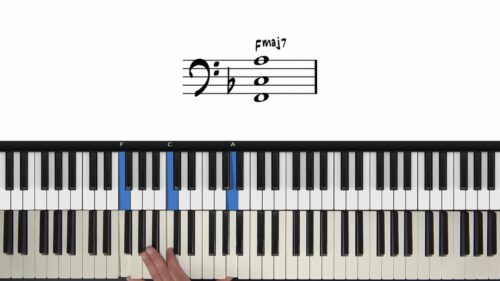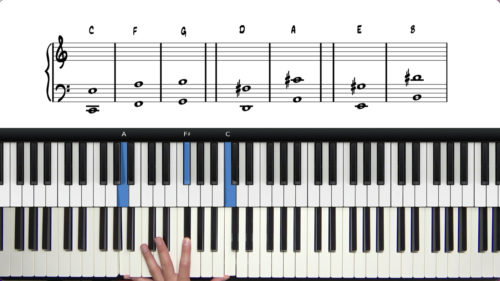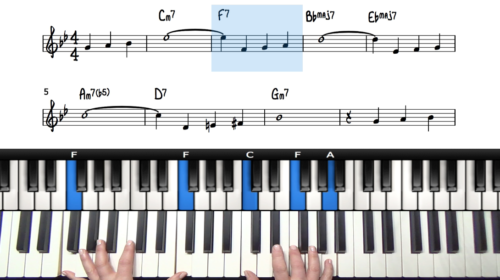10th Intervals & Harmonizing with 3rds & 6ths
Welcome to the final lesson in our novice-level exploration of the jazz standard "Fly Me to the Moon". In this lesson, we’ll build on the foundational harmony and voicings we’ve covered, introducing new techniques that add variety and depth to your performance.
Jazz Piano 10th Intervals For Beginners
Throughout this lesson, we’ll revisit the concept of 10th intervals in the left hand—a technique you may recall from our lessons on the tune "Moon River" earlier in this course. 10th intervals create a stronger harmonic foundation simply by restructuring the notes of simple triad shapes. For example, instead of playing the notes of an A minor triad sequentially, you can space them out as follows:

Notice that we simply move the root note an octave down and position the 3rd and 5th above it. This rearrangement strengthens the chord’s harmonic effect and creates a fuller sound in the lower registers of the piano. 10th intervals are a invaluable voicing technique for jazz pianists.

While 10th voicings may be challenging to execute, remember to adjust your approach by rolling notes or using the pedal to make these long stretches more manageable. With time you will build up the strength and muscle memory to execute 10th voicings cleanly.
Harmonizing Melodies with 3rds & 6ths
As we’ve learned in previous lessons in this course, jazz standards often have repetitive sections such as ABAC or AABA as you will learn in the next Novice courses. This repetition offers an opportunity to vary our playing with different voicing and melodic techniques.
Harmonizing the melody is useful technique to add melodic richness to our performance and create variety in repeating sections. By harmonising the melody with 3rds or 6ths we can create a more resonant and layered sound. However, these harmonizations require careful attention to hand positioning and can be physically demanding particularly when first attempting them. It’s essential to be patient and allow your hands to adapt gradually to these new shapes.
Bringing It All Together: Flexibility and Variation
One of the key takeaways from this lesson is the importance of flexibility in your approach. As you become more comfortable with these techniques, you’ll find that your arrangements of "Fly Me to the Moon" will evolve over time. Jazz is an ever-changing art form, where each new theory or concept you learn can be applied to refresh and reinvent your interpretations of standards.
Practice Tips
-
Experiment with 10th Intervals: Start by practicing simple triads in the left hand, then expand them into 10th intervals to strengthen the harmonic foundation of your left hand.
-
Explore Spread Voicings: Work on distributing chord tones between both hands, adjusting for register and melodic context.
-
Harmonize with 3rds and 6ths: Experiment harmonizing the melody using 3rd and 6th intervals. Start slowly and gradually speed up.
-
Vary Your Register: Practice playing the same melody in different registers of the piano to understand how it affects the overall sound and how this can open up new possibilities for voicings and melodic embelishment.
- Always Be Flexible: Try different combinations of voicings and harmonizations, allowing your arrangements to evolve as you incorporate new techniques.







Hello,
I have just joined Pianogroove and am really enjoying it. I have just completed the beginners guide to lead sheets and am not sure which course to choose next. Is there a structured learning matrix which tells me which courses to do in which order, or should i just work through all of the beginners jazz courses in any order i fancy?
Many thanks, Russell
Hi Russel,
Firstly, apologies for the late reply – I had a few gigs over the weekend and I’m just catching up on comments and questions.
I’m really glad to hear you are enjoying the lessons and courses.
Yes have you checked out the syllabus/learning path section here: pianogroove.com/syllabuses/
—-
I recommend the “Lead Sheet Fundamentals” learning path as a good place to start for new students – pianogroove.com/syllabuses/lead-sheet-fundamentals/
This learning path covers 9 jazz standards with simple yet beautiful arrangements. The goal of this learning path is to build out your repertoire of jazz standards and learn basic skills for harmonising lead sheets.
We cover these 9 tunes throughout the PianoGroove courses and seminars and so learning the basic arrangement provides strong foundations upon which we can add more advanced theory and jazz harmonisation techniques.
You have already completed the first course in this learning path and so there are 4 other courses remaining. That would be my main suggestion for you.
—-
To move at a faster pace through the theory, check out the Essential Jazz Harmony learning path – pianogroove.com/syllabuses/beginners-jazz-syllabus/ – this contains 5 courses which I deem to be the most important theory elements for beginner and early-intermediate jazz studies.
Generally I recommend new jazz piano students to start with the “Lead Sheet Fundamentals” learning path, and then move onto the “Essential Jazz Harmony” learning path.
—
A final option is to study our Dedicated Jazz Standard Courses.
These are in-depth courses of 15 to 20 lessons focusing on a single tune. Think of them as Jazz Standard Masterclasses where I share my insights and discoveries from playing these songs for many years:
“Misty” – Cocktail Piano Improv: pianogroove.com/jazz-piano-lessons/cocktail-improvisation-for-beginners/
“Nearness Of You” – Ballad Fills & Runs: pianogroove.com/jazz-piano-lessons/ballad-voicings-fills-improv/
“Body & Soul” – Elegant Stride Piano: pianogroove.com/jazz-piano-lessons/elegant-stride-improvisation/
“Georgia” – Bluesy Stride Piano: pianogroove.com/blues-piano-lessons/bluesy-stride-piano-beginners/
These courses are mixed-level, starting with basic 3-notes voicings and then each lesson introduces new voicing options and arranging techniques.
—-
Please take a look over the links and suggestions above – and let me know if you’d like any more recommendations.
Talk soon,
Hayden